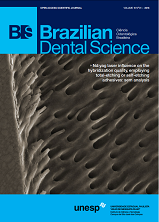Evaluation of TMD signals and symptoms in individuals undergoing orthodontic treatment
DOI:
https://doi.org/10.14295/bds.2016.v19i1.1236Abstract
Objetivo: verificar a presença de sinais e sintomas de DTM em indivíduos em tratamento ortodôntico. Material e Métodos: foram avaliados 28 indivíduos que estavam em tratamento ortodôntico na clínica de uma faculdade do estado de São Paulo. Para identificar a presença de DTM foi utilizado o Research Diagnostic Criteria for Temporomandibular Disorders (RDC-TMD). A dor foi avaliada pela Escala Visual Analógica (EVA). A amplitude, dor e ruído durante os movimentos mandibulares, além da dor à palpação de músculos intra e extra orais e cervicais foram aferidos pelo Índice Craniomandibular (ICM). O limiar de dor à pressão foi avaliado por meio de algômetro. Os valores médios e desvio padrão foram obtidos e a análise foi expressa em porcentagem. Resultados: o RDC-TMD demonstrou que a maioria dos indivíduos não apresentaram DTM, que 3,57% apresentaram osteoartrite, 10,71% artralgia, 3,57% deslocamento de disco sem redução, 7% dor miofascial e 14,28% dor miofascial com limitação de abertura; A EVA evidenciou dor média de 1,37 cm (DP=1,4). A média do ICM foi de 0,26 (DP=0,14). O limiar de dor à pressão aferido com algômetro foi de 3,7 (DP=1,7) para o m. temporal anterior e de 3,00 (DP=1,2) para o feixe superficial do m. masseter inferior. Conclusão: foram observados sinais e sintomas de DTM em 39,13% dos indivíduos em tratamento ortodôntico.
Downloads
Downloads
Additional Files
Published
How to Cite
Issue
Section
License
Brazilian Dental Science uses the Creative Commons (CC-BY 4.0) license, thus preserving the integrity of articles in an open access environment. The journal allows the author to retain publishing rights without restrictions.
=================




























